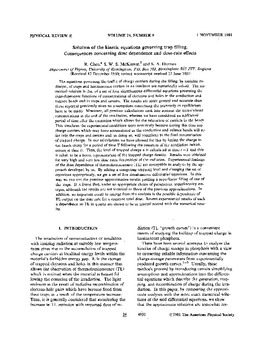| dc.contributor.author | Chen, R. | |
| dc.contributor.author | McKeever, S. W. S. | |
| dc.contributor.author | Durrani, S. A. | |
| dc.date.accessioned | 2015-10-16T20:48:26Z | |
| dc.date.available | 2015-10-16T20:48:26Z | |
| dc.date.issued | 1981-11-01 | |
| dc.identifier | okds_McKeever_PRB_1981-11-01 | |
| dc.identifier.citation | Chen, R., McKeever, S. W. S., & Durrani, S. A. (1981). Solution of the kinetic equations governing trap filling. Consequences concerning dose dependence and dose-rate effects. Physical Review B, 24(9), 4931-4944. https://doi.org/10.1103/PhysRevB.24.4931 | |
| dc.identifier.uri | https://hdl.handle.net/11244/19921 | |
| dc.description.abstract | The equations governing the traffic of charge carriers during the filling, by ionizing radiation, of traps and luminescence centers in an insulator are numerically solved. The numerical solution is that of a set of four simultaneous differential equations governing the time-dependent functions of concentrations of electrons and holes in the conduction and valence bands and in traps and centers. The results are more general and accurate than those reported previously since no assumptions concerning the proximity to equilibrium have to be made. Moreover, all previous calculations took into account the accumulated concentrations at the end of the irradiation, whereas we have considered an additional period of time after the excitation which allows for the relaxation of carriers in the bands. This simulates the experimental conditions more accurately because during this time any charge carriers which may have accumulated in the conduction and valence bands will relax into the traps and centers and, in doing so, will contribute to the final concentration of trapped charge. In our calculations we have allowed for this by letting the charge in the bands decay for a period of time T following the cessation of the irradiation (which occurs at time t). Thus, the level of trapped charge n is calculated at time t+ T and this is taken to be a better representation of the trapped charge density. Results were obtained for very high and very low dose rates (intensities) of the radiation. Experimental findings of the dose dependence of thermoluminescence (TL) are susceptible to analysis by the approach developed by us. By adding a competing trapping level and changing the set of equations appropriately, we get a set of five simultaneous differential equations. In this way we can test the previous approximative results yielding a superlinear filling of one of the traps. It is found that, under an appropriate choice of parameters, superlinearity emerges, although the results are not identical to those of the previous approximations. In addition, an important result to emerge from the analysis is the possible dependence of TL output on the dose rate for a constant total dose. Recent experimental results of such a dependence on TL in quartz are shown to be in general accord with the numerical results. | |
| dc.format | application/pdf | |
| dc.language | en_US | |
| dc.publisher | American Physical Society | |
| dc.rights | This material has been previously published. In the Oklahoma State University Library's institutional repository this version is made available through the open access principles and the terms of agreement/consent between the author(s) and the publisher. The permission policy on the use, reproduction or distribution of the material falls under fair use for educational, scholarship, and research purposes. Contact Digital Resources and Discovery Services at lib-dls@okstate.edu or 405-744-9161 for further information. | |
| dc.title | Solution of the kinetic equations governing trap filling. Consequences concerning dose dependence and dose-rate effects | |
| osu.filename | okds_McKeever_PRB_1981-11-01.pdf | |
| dc.description.peerreview | Peer reviewed | |
| dc.identifier.doi | 10.1103/PhysRevB.24.4931 | |
| dc.description.department | Physics | |
| dc.type.genre | Article | |
| dc.type.material | Text | |
| dc.subject.keywords | electric current carriers (kinetic equation for luminescent centers in insulators filled by) | |
| osu.authorOrcid.uri | https://orcid.org/0000-0002-7286-898X | |
